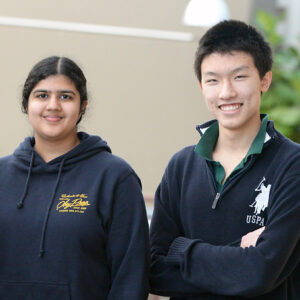Video of this event is available on The Harker School’s YouTube channel: Part 1, Part 2
Right on the heels of astronaut Greg Chamitoff’s appearance, the Harker Speaker Series hosted another fascinating space-themed talk by Dr. Jill Tarter, director of Search for Extraterrestrial Intelligence (SETI) research at the SETI Institute in Mountain View. A well-known figure in the search for life on other worlds, Tarter’s research formed the basis for Jodie Foster’s character in the popular science fiction film “Contact.”
After introductions by Chris Nikoloff, head of school, and Harker student Govi Dasu, grade 12, an astrophysics enthusiast, Tarter jumped right into her presentation, titled, “Citizen Science and the Search for E.T.”
She explained that she and her team use radio telescopes to search for evidence of extraterrestrial (ET) intelligence, juxtaposing a photo of herself at a computer with a photo of Jodie Foster in “Contact” listening for signals with a pair of headphones. “I’m the one that doesn’t wear headphones,” Tarter quipped.
Tarter’s entire career as a scientist has been spent on SETI research, having served as a SETI project scientist with NASA, and then becoming the first employee at SETI when it incorporated in 1984. “I’ve only actually had two jobs in my life,” she said. Her current project is being the self-described “chief cheerleader” of setiQuest, an effort to engage the open community in SETI’s mission.
“We’re all transitioning,” said Tarter
. “At my ripe old age, I’m trying to learn how to do my business in a different way.” She used the language of the open-source computing community in saying that SETI was “moving away from the cathedral” of doing research on their own using large instruments, and moving toward “the bazaar,” a rich source of ideas and innovation.
“But it’s a little bit rough and tumble, too,” she explained. “You’ve got to have some sharp elbows and a thick skin to do well in this environment, and that’s what we’re trying to learn how to do, because we realize that not all smart people who are interested and passionate about SETI actually work for the SETI Institute, and they can help us to improve the search.”
Tarter then moved on to the greater topic of SETI research. “There are answers to questions about what is, what ought to be, who are we, why are we, and of course, who else might be out there,” she began. “Along that journey, we’ve discovered that our universe is vast, that our sun is one of 400 billion stars in the Milky Way Galaxy.” As massive as that sounds, the Milky Way is only one of 100 billion galaxies in the observable universe, which itself only makes up four percent of the universe’s mass energy density. The rest she said, is made up of “dark matter, dark energy. ‘Dark’ is just an astronomical word for ‘we don’t know.’”
She pointed out that SETI research hasn’t set out to prove the assumed existence of sentient extraterrestrial life. “We just note the possibility, probably even the probability, given the size and the uniformity of the universe we find ourselves in,” she said.
Since 1995, about 550 planets have been found by watching stars that wobble as their planets orbit around them. The Kepler spacecraft, launched in 2009, has been searching for Earth-sized planets in orbit around stars similar to the sun, which may be the right temperature to contain liquid water necessary for life. Using its 95-megapixel camera to detect dips in the brightness of stars caused by their planets’ orbits, Kepler identified 1,235 exoplanet (the term for planets existing outside the solar system) candidates by staring at a tiny patch of the Milky Way between the Cygnus and Lyra constellations. Of those, Tarter said, 60 may be situated in the so-called “Goldilocks zone,” orbiting just the right distance from their stars to house the right temperature for liquid water.
That data, released in February, was followed up in September by another large set of data, which doubled the number of exoplanet candidates. One of Kepler’s most fascinating discoveries from that set was Kepler 16b, the first planet known to orbit two stars.
Although Kepler 16b is likely too cold to be habitable, “it shows us that it’s possible to have planets in stable orbits around binary stars, and since most stars out there are binaries, this is a whole lot more real estate that we know is out there, and some of it might be habitable,” Tarter said. Using statistical math, Tarter estimated that “maybe 500 million” planets in our galaxy are habitable.
In addition to people who search for life, Tarter said the SETI institute also employs astrobiologists who study the “origin, evolution, distribution and future of life in the universe.” In order to understand what types of planets may be able to sustain life, they study life forms that are able to withstand extreme conditions here on Earth. “My colleagues are trying to find the answer to the question of what constitutes a biosignature,” she said. The presence of methane in our atmosphere caused by everything from termites to what Tarter termed “bovine flatulence,” for example, is one clue of the biological happenings on the surface. “Biology is leaving an imprint on our atmosphere, and perhaps we can find something like that in the atmospheres of other planets, but it’s very tricky to be able to say with absolute confidence that that particular chemical signature cannot be produced abiotically,” she said.
The presence of technology on other worlds is also a concern for SETI research, which also looks for so-called “technosignatures” from extrasolar planets. While earthly technologies could be detected by an advanced civilization, receiving their communications is another matter. “Our own technologies are in fact visible at interstellar distances by an advanced technology,” Tarter said, “and perhaps their technology could be detected by us at radio or optical or some other wavelength, if we only had a determined search to systematically look for it.”
SETI’s success is not only dependent upon whether or not other civilizations exist, but also whether or not their technology lasts long enough on a cosmic time scale. “We are a very young technology, 100 years, in a very old galaxy, whose age is 10 billion years,” she said. “Can we become an old technology? Is technology on average a stabilizing influence, and do technologies last for a long time?”
Tarter wrapped up her presentation with a summary of how the SETI Institute has been trying to build a worldwide community to assist in their research. Their primary audience, she said, is college students. “They’re going to be responsible for our technological longevity. They’re going to solve the technical challenges that we’ve presented to them from technologies we’ve previously produced and not used wisely.” One way they have engaged this audience is to publish their code as open source so that it can be improved.
To involve the community beyond universities, SETI Institute is working on a “citizen science” application that will hopefully enable people to find what SETI researchers may have missed by “allowing humans to do what they do best, which is pattern recognition,” Tarter said.
In building the setiQuest community, the institute has also received help from Google, Dell, Intel and Amazon. The setiQuest explorer application is now available as a Web browser app and is also available for free on Android smartphones and tablets. Tarter admitted that the application needs improvement. However, the data they are receiving from the application will eventually allow them to start a new citizen science project with the help of Galaxy Zoo, an organization that allows website visitors to help classify galaxies. This project will feed users data from telescopes in real time to help SETI researchers sift through particularly crowded bands, “where there are so many signals and we can’t figure out where they are,” Tarter said.
During a brief question and answer session following the presentation, Tarter answered a question from an audience member that dealt with what to do in the event of being contacted by another world. In such a scenario, she explained, the first step would be to tell the world what has happened. There is also a piece known as Article 8, which states that Earth will not respond to the message until a global consensus is reached on what the response will be.
She said she was confident, however, that any such correspondence would not be hostile, as any civilization advanced enough to send a message over such a great length, would probably have been around long enough to be peaceful. “I’m a bit of a Polyanna,” she joked.









